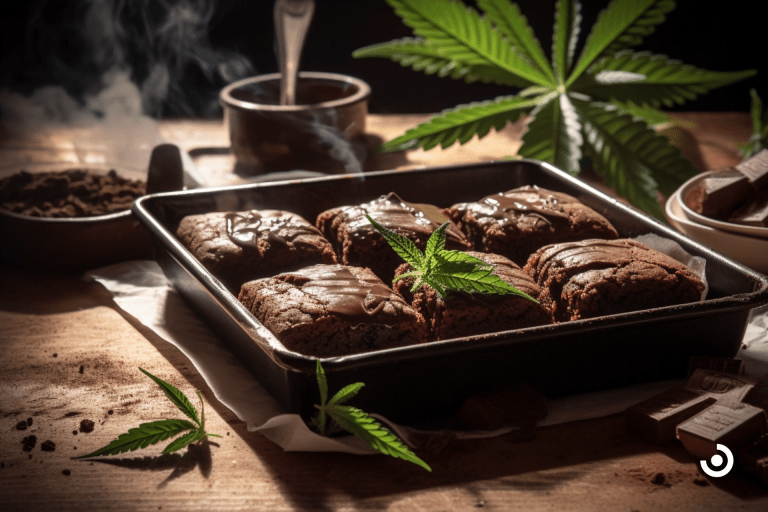Why Are My Weed Plants Turning Yellow?
by Haley Mills · November 15, 2023
Is your weed plant turning yellow? Learn the ultimate solution to vibrant green marijuana plants and how to fix it now! Don’t miss out on this must-read guide. Click here for expert tips!

Are you a cannabis enthusiast who has noticed your weed plants turning yellow? If so, you may be wondering what could be causing this alarming change in color.
Yellowing in weed plants can be a sign of various issues, including nutritional deficiencies, over or underwatering, pest infestations, diseases, and environmental stressors. In this article, we will delve into each of these factors, providing you with a comprehensive understanding of why your weed plants may be turning yellow and how to address the underlying problems.
Nutritional deficiencies and imbalances can often be a major culprit behind yellowing in weed plants. Cannabis plants require a balanced and adequate supply of essential nutrients, such as nitrogen, phosphorus, and potassium, among others. When these nutrients are lacking or imbalanced, it can lead to yellowing of the leaves. Additionally, deficiencies in micronutrients like iron, magnesium, or zinc can also contribute to the yellowing of leaves.
Understanding the specific nutrient requirements of your weed plants and ensuring they receive the proper balance is crucial in preventing and addressing yellowing issues.
Over or underwatering can also cause yellowing in weed plants. Overwatering can lead to root rot, preventing the roots from absorbing necessary nutrients, resulting in yellowing leaves. On the other hand, underwatering can cause stress to the plant, leading to nutrient deficiencies and subsequent yellowing.
Achieving the right balance in watering is essential for the overall health of your weed plants and can help prevent yellowing. By closely monitoring the soil moisture and adjusting your watering practices accordingly, you can establish an environment that promotes healthy growth and minimizes the risk of yellowing.
Key Takeaways
- Various factors, including fungal infections and environmental stressors can cause yellowing of weed plants.
- To address yellowing, try to remove infected leaves, improve air circulation, and consider using fungicides.
- Wilting or stunted growth in weed plants can be attributed to root rot or bacterial infections, which can be tackled through proper drainage and the use of fungicides or bactericides.
- Environmental factors such as lack of sunlight, inadequate water supply, high temperatures, excessive wind, pollution, and chemical exposure can also contribute to yellowing. Therefore, it is crucial to provide proper care to the plants, including adequate sunlight, water, and nutrients, while also protecting them from harmful chemicals and using organic pest control methods.
Identifying Common Causes of Yellowing in Weed Plants
Soil pH levels play a crucial role in the overall health and growth of weed plants. If the pH level of the soil is too high or too low, it can lead to nutrient deficiencies or imbalances, which can manifest as yellowing leaves. Most weed plants prefer a slightly acidic soil, with a pH level between 6 and 7. When the pH level is outside of this range, certain nutrients become less available to the plants, causing yellowing. To determine the pH level of your soil, you can use a pH testing kit or send a sample to a laboratory for analysis. If the pH level is off, you can adjust it by adding amendments such as limestone to raise the pH or sulfur to lower it.
Another factor to consider is light intensity. Weed plants require a specific amount of light to carry out photosynthesis, the process by which they convert light into energy. If the light intensity is too high or too low, it can result in yellowing leaves. Inadequate light can cause a lack of chlorophyll production, leading to yellowing. On the other hand, excessive light can cause photobleaching, which damages the chlorophyll and results in yellowing. Provide your weed plants with the right amount of light for their specific needs. This can vary depending on the strain and stage of growth. Using a light meter can help you determine if your plants are receiving the appropriate amount of light.
Nutritional Deficiencies and Imbalances
To prevent yellowing, ensure your marijuana plants receive proper nutrition and maintain a balanced nutrient intake. One factor to consider is the soil pH and its effect on nutrient uptake. Marijuana plants thrive in slightly acidic soil with a pH level between 6 and 7. If the soil pH is too high or too low, it can hinder the plants’ ability to absorb essential nutrients, leading to deficiencies and yellowing of the leaves.
It’s recommended to regularly test the pH level of your soil and make adjustments accordingly to maintain optimal nutrient uptake.
Another factor to consider is the type of nutrients you’re using for your marijuana plants. Organic and synthetic nutrients can both lead to deficiencies if not used correctly. Organic nutrients are derived from natural sources and can provide a more balanced and slow-release form of nutrients. However, they can also be more prone to deficiencies if not properly broken down and made available to the plants.
On the other hand, synthetic nutrients are chemically formulated to provide specific ratios of nutrients, which can be more readily available to the plants. However, using too much synthetic nutrients can result in nutrient imbalances and deficiencies.
To prevent nutritional deficiencies and imbalances, it’s essential to closely monitor your plants’ nutrient intake and adjust accordingly. Regularly check the pH of your soil and make necessary adjustments to ensure optimal nutrient uptake.
Consider using a balanced mix of organic and synthetic nutrients to provide a diverse range of nutrients to your marijuana plants. By maintaining a proper nutrient balance, you can help prevent yellowing and ensure healthy growth and development of your weed plants.
Over or Underwatering
You may be experiencing yellowing of your marijuana plants due to either over or underwatering. Both overwatering and underwatering can have adverse effects on the health and growth of your plants.
Overwatering is a common mistake made by many growers. When you overwater your plants, the roots become saturated and lack access to oxygen. This can lead to root rot and hinder the absorption of nutrients, resulting in yellowing leaves. Overwatering signs include wilting, drooping leaves, and a damp soil surface. Additionally, you may notice the development of mold or fungus on the soil or the plant itself. To prevent overwatering, ensure that your pots have adequate drainage holes and allow the soil to dry out between waterings.
On the other hand, underwatering can also cause yellowing of your marijuana plants. When plants do not receive enough water, they’re unable to perform photosynthesis efficiently, leading to a lack of chlorophyll production and yellowing leaves. Underwatering signs include dry and brittle leaves, curling or wilting, and a dry soil surface.
Water your plants thoroughly and consistently, ensuring that the soil is moist but not waterlogged. Regularly check the moisture level of the soil by sticking your finger about an inch deep into the soil. If it feels dry, it’s time to water your plants.
Pest Infestations and Diseases
Pest infestations and diseases can cause the leaves of your cannabis plants to take on a yellow hue. These issues can be detrimental to the health and growth of your plants, so try to to address them promptly.
Here are some prevention methods for pest infestations in weed plants:
- Regularly inspect your plants: Regularly inspecting your plants can help you identify any signs of pests early on. Look for any unusual spots, discoloration, or damage to the leaves. Inspect both the upper and lower surfaces of the leaves, as well as the stems and buds.
- Keep a clean growing environment: A clean growing environment can help deter pests from infesting your plants. Remove any dead leaves or debris from around your plants, as these can attract pests. Additionally, regularly sanitize your grow space and tools to prevent the spread of pests and diseases.
- Use natural pest control methods: Instead of relying on chemical pesticides, consider using natural pest control methods. These can include introducing beneficial insects, such as ladybugs or predatory mites, to your garden. You can also make homemade sprays using ingredients like neem oil or garlic to repel pests.
When it comes to diseases in weed plants, you’ll want to be able to identify common symptoms and know the appropriate treatments.
Here are some common symptoms and treatments for diseases in weed plants:
- Yellowing leaves: Yellowing leaves can be a sign of various diseases, such as nutrient deficiencies or fungal infections. To treat this, ensure your plants receive adequate nutrients and adjust your watering schedule if necessary. If the issue persists, you may need to use a fungicide.
- Spots or lesions on leaves: Spots or lesions on leaves can indicate diseases like powdery mildew or leaf spot. Treatments for these diseases can include removing and destroying infected leaves, improving air circulation, and applying fungicides.
- Wilting or stunted growth: Wilting or stunted growth can be caused by diseases like root rot or bacterial infections. To address these issues, ensure proper drainage in your growing medium and avoid overwatering. If necessary, use a fungicide or bactericide to treat the plants.
By being vigilant and taking preventive measures, as well as promptly addressing any pest infestations or diseases, you can help ensure the health and vitality of your weed plants.
Environmental Factors and Stressors
Environmental factors and stressors can contribute to the yellowing of weed plants. These adverse effects can occur due to a variety of reasons, including improper plant care and exposure to extreme conditions. For instance, if the plants aren’t receiving sufficient sunlight, they may develop chlorosis, a condition characterized by yellowing leaves. This happens because sunlight is essential for the process of photosynthesis, which is responsible for producing energy and nutrients for the plants.
Inadequate water supply or poor drainage can also lead to yellowing leaves, as water is crucial for transporting nutrients throughout the plant. Additionally, high temperatures can cause stress to the plants, resulting in yellowing and wilting leaves.
Furthermore, environmental stressors such as excessive wind, pollution, or exposure to chemicals can negatively impact the health of weed plants. Strong winds can damage the leaves, making them more prone to yellowing and discoloration. Pollution, particularly air pollution, can cause damage to the surface of leaves and interfere with the plants’ ability to absorb sunlight and nutrients. Additionally, exposure to chemicals like pesticides or herbicides can have adverse effects on the plants, leading to yellowing and other signs of distress.
In order to prevent or address yellowing caused by environmental factors and stressors, it’s important to provide proper plant care. This includes ensuring that the plants are receiving adequate sunlight, water, and nutrients. If sunlight is limited, consider moving the plants to a more suitable location or providing supplemental light sources.
Regular watering and proper drainage are crucial to maintaining the health of the plants and preventing yellowing. Shielding the plants from excessive wind or pollution, such as by using windbreaks or protective covers, can also help minimize stress and damage. Additionally, avoiding the use of harmful chemicals and opting for organic pest control methods can help protect the plants from further damage.
Frequently Asked Questions
How often should I water my weed plants?
For optimal watering techniques, it is important to monitor the moisture levels of the soil. Signs of under watering include wilting and dry soil, while over watering can lead to yellowing leaves and root rot.
What are some common pests that can infest weed plants?
Some common pests that can infest weed plants include aphids, spider mites, and whiteflies. Natural predators like ladybugs and lacewings can help control these pests, while organic pest control measures include neem oil and insecticidal soaps.
Can over-fertilizing cause yellowing in weed plants?
Over-fertilizing can cause yellowing in weed plants. It occurs when nutrient levels exceed what the plants can absorb, leading to nutrient imbalances. Proper pH levels are crucial for healthy growth as they affect nutrient availability. Understanding the difference between nutrient deficiencies and over-fertilizing is essential.
Are there any specific environmental factors that can cause yellowing in weed plants?
Nutrient deficiencies can cause yellowing in weed plants. Signs include yellowing leaves and stunted growth. Solutions include adjusting the pH levels, as pH imbalance can affect nutrient absorption. Testing soil and using appropriate fertilizers can address these issues.
How can I prevent diseases from affecting my weed plants?
To prevent diseases in weed plants, it is important to consider organic and chemical methods. Organic methods include using beneficial insects and disease-resistant strains, while chemical methods involve using fungicides and pesticides. Proper ventilation is crucial in preventing diseases as it helps control humidity and prevent the buildup of pathogens.
Last Updated: August 8, 2024
Get Approved for Your Medical Marijuana Card in Minutes!

Get Your Medical Card
Connect with a licensed physician online in minutes

Like This Article?
Share with your friends
Table of Contents
Keep Reading
-
What You Need to Know: Does Weed Help with Vertigo?
Discover if weed helps with vertigo symptoms and learn about its potential benefits.
-
Delicious Recipes For Cooking With Medical Marijuana In Ohio
Looking for delectable recipes using medical marijuana in Ohio? Elevate your cooking game with these mouthwatering dishes and explore a whole new world of flavors. Click now to discover delicious recipes for cooking with Ohio medical cannabis today!
-
The Comprehensive Guide To Weed Shatter
Everything you need to know about weed shatter – the ultimate guide to unlocking the secrets of this potent cannabis concentrate.



